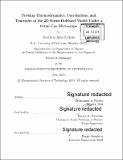| dc.contributor.advisor | Martin W. Zwierlein. | en_US |
| dc.contributor.author | Nichols, Matthew Alan. | en_US |
| dc.contributor.other | Massachusetts Institute of Technology. Department of Physics. | en_US |
| dc.date.accessioned | 2020-01-08T19:43:08Z | |
| dc.date.available | 2020-01-08T19:43:08Z | |
| dc.date.copyright | 2019 | en_US |
| dc.date.issued | 2019 | en_US |
| dc.identifier.uri | https://hdl.handle.net/1721.1/123409 | |
| dc.description | Thesis: Ph. D., Massachusetts Institute of Technology, Department of Physics, 2019 | en_US |
| dc.description | Cataloged from PDF version of thesis. | en_US |
| dc.description | Includes bibliographical references (pages 389-408). | en_US |
| dc.description.abstract | Ultracold fermionic atoms in optical lattices offer a pristine platform for quantum simulation of materials with strong electron correlations. With the advent of quantum gas microscopy, we now have the abilities to observe and manipulate these systems at the level of single atoms and lattice sites. In this thesis, I will describe how we perform fluorescence microscopy on fermionic 4K using Raman sideband cooling, and how we realize the two-dimensional Fermi-Hubbard model on a square lattice, a paradigm believed to capture the essence of high-Tc superconductivity in the cuprates. I will then discuss several experiments we have performed with this system aimed at improving our current understanding of both the equilibrium and transport properties of this strongly correlated many-body Hamiltonian. | en_US |
| dc.description.abstract | The first part of this thesis discusses measurements of thermodynamic properties of different states of the Fermi-Hubbard model in equilibrium, including metallic, Mott-insulating, and band-insulating states. With the single-site resolution afforded by our quantum gas microscope, we examine spatial spin and charge correlations in a fermionic Mott insulator as a function of the filling in the lattice. At halffilling, we observe antiferromagnetic spin correlations in the presence of doublonhole bunching. Upon doping, these spin correlations weaken monotonically, and an interaction-enhanced Pauli-hole emerges, a real-space manifestation of Pauli-blocking. | en_US |
| dc.description.abstract | The second part of this thesis describes near-equilibrium transport experiments we performed with ultracold fermionic atoms, which allowed us to measure both the spin diffusion coefficient and the spin conductivity of a homogeneous Mott insulator at halffilling, transport coefficients that are difficult to measure in the cuprates, and which are highly challenging to calculate theoretically. In the strongly interacting regime, we observe diffusive spin transport that is driven by super-exchange and doublon-hole-assisted tunneling, and which violates the quantum limit of charge diffusion. | en_US |
| dc.description.statementofresponsibility | by Matthew Alan Nichols. | en_US |
| dc.format.extent | 408 pages | en_US |
| dc.language.iso | eng | en_US |
| dc.publisher | Massachusetts Institute of Technology | en_US |
| dc.rights | MIT theses are protected by copyright. They may be viewed, downloaded, or printed from this source but further reproduction or distribution in any format is prohibited without written permission. | en_US |
| dc.rights.uri | http://dspace.mit.edu/handle/1721.1/7582 | en_US |
| dc.subject | Physics. | en_US |
| dc.title | Probing thermodynamics, correlations, and transport of the 2D Fermi-Hubbard model under a Fermi gas microscope | en_US |
| dc.type | Thesis | en_US |
| dc.description.degree | Ph. D. | en_US |
| dc.contributor.department | Massachusetts Institute of Technology. Department of Physics | en_US |
| dc.identifier.oclc | 1133655631 | en_US |
| dc.description.collection | Ph.D. Massachusetts Institute of Technology, Department of Physics | en_US |
| dspace.imported | 2020-01-08T19:43:07Z | en_US |
| mit.thesis.degree | Doctoral | en_US |
| mit.thesis.department | Phys | en_US |
